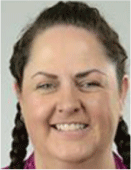Geochemical evidence for a new Triassic petroleum system on the western margin of Australia
Emmanuelle Grosjean A B , Dianne S. Edwards A , Nadege Rollet A , Christopher J. Boreham A , Duy Nguyen A and Tamara Buckler AA Geoscience Australia, GPO Box 378, Canberra, ACT 2601, Australia.
B Corresponding author. Email: emmanuelle.grosjean@ga.gov.au
The APPEA Journal 61(2) 616-625 https://doi.org/10.1071/AJ20027
Accepted: 16 March 2021 Published: 2 July 2021
Journal Compilation © APPEA 2021 Open Access CC BY
Abstract
The unexpected discovery of oil in Triassic sedimentary rocks of the Phoenix South 1 well on Australia’s North West Shelf (NWS) has catalysed exploration interest in pre-Jurassic plays in the region. Subsequent neighbouring wells Roc 1–2, Phoenix South 2–3 and Dorado 1–3 drilled between 2015 and 2019 penetrated gas and/or oil columns, with the Dorado field containing one of the largest oil resources found in Australia in three decades. This study aims to understand the source of the oils and gases of the greater Phoenix area, Bedout Sub-basin using a multiparameter geochemical approach. Isotopic analyses combined with biomarker data confirm that these fluids represent a new Triassic petroleum system on the NWS unrelated to the Lower Triassic Hovea Member petroleum system of the Perth Basin. The Bedout Sub-basin fluids were generated from source rocks deposited in paralic environments with mixed type II/III kerogen, with lagoonal organofacies exhibiting excellent liquids potential. The Roc 1–2 gases and the Phoenix South 1 oil are likely sourced proximally by Lower–Middle Triassic TR10–TR15 sequences. Loss of gas within the Phoenix South 1 fluid due to potential trap breach has resulted in the formation of in-place oil. These discoveries are testament to new hydrocarbon plays within the Lower–Middle Triassic succession on the NWS.
Keywords: Roebuck Basin, Bedout Sub-basin, fluids, source rocks, organic geochemistry, biomarkers, isotopes, Triassic, Keraudren Formation.

Emmanuelle Grosjean is a petroleum geochemist at Geoscience Australia working in the Minerals, Energy and Groundwater Division. She applies organic geochemistry to assess the hydrocarbon prospectivity of Australia’s offshore and onshore sedimentary basins. She has recently been involved in building database systems to release petroleum geochemical data via the portal https://portal.ga.gov.au. She holds a doctorate degree in organic chemistry from the University of Strasbourg, France. Before joining Geoscience Australia in 2005, she worked on the Precambrian petroleum systems of the South Oman Salt Basin as a post-doctoral associate at the Massachusetts Institute of Technology. |

Dianne Edwards is a senior petroleum geochemist at Geoscience Australia working in the Minerals, Energy and Groundwater Division. Her scientific focus is on defining the petroleum systems of Australia’s petroliferous basins including both conventional and unconventional play types. She is involved in building database systems to release petroleum geochemical data via the portal https://portal.ga.gov.au. She received her BSc (Hons) degree in geology and MSc in organic petrology and organic geochemistry from the University of Newcastle-upon-Tyne (UK). She was awarded a PhD from the University of Adelaide in 1996. In 2018, she received the Australian Organic Geochemistry Conference Medal for lifetime achievement in the field of organic geochemistry. She is a member of PESA. |

Nadège Rollet is a senior geoscientist in Geoscience Australia’s Minerals, Energy and Groundwater Division. She is currently investigating the petroleum prospectivity of the central North West Shelf of Australia. She obtained a MSc and a PhD (1999) in geology and geophysics from the University of Paris – Pierre et Marie Curie (France). Her studies focused on the structural framework and geodynamics of the Ligurian Sea (western Mediterranean). Since joining Geoscience Australia, she has contributed to marine surveys around Australia, assessments of the petroleum prospectivity, seepage studies and CO2 storage of Australian sedimentary basins. She is a member of PESA. |

Christopher J. Boreham is a principal petroleum geochemist at Geoscience Australia working in the Minerals, Energy and Groundwater Division. He obtained his BSc (Hons) in chemistry from the University of Queensland and was awarded a PhD in chemistry at ANU. He has worked at Geoscience Australia for four decades. He has a wide experience in the application of organic geochemistry to the evolution of oil and gas in Australian sedimentary basins. He has recently extended these geochemical studies to unconventional petroleum (coal seam methane, shale gas and oil), helium, hydrogen and abiogenic hydrocarbons, as well as being involved in CO2CRC’s studies on the injection of CO2 into a depleted natural gas field and a saline aquifer. In 2010, he received the Australian Organic Geochemistry Conference Medal for lifetime achievement in the field of organic geochemistry. He is a member of PESA. |

Duy (Victor) Nguyen is a senior petroleum engineer at Geoscience Australia working in the Minerals, Energy and Groundwater Division where he has extensive expertise on the Browse, Roebuck and Otway basins. He holds BE and ME (petroleum engineering) degrees from the University of New South Wales. As part of his degrees, he researched the techno-economics of CO2 geological sequestration in Australia. He has five years of oil and gas industrial experience working for Schlumberger in Australia, Malaysia, India, the Middle East and Africa. Since 2009, he has worked on the assessment of the CO2 geological storage potential of the Bonaparte, Gippsland and Browse basins. |

Tamara Buckler is a data manager at Geoscience Australia working in the Minerals, Energy and Groundwater Division. She has worked extensively with the maintenance and upgrade of the oracle databases since commencing work with the Australian Geological Survey Organisation in 1996. She has completed Data Management and Oracle training and manages several corporate Oracle databases, including the petroleum geochemistry database. She is involved in building database systems to release petroleum geochemical data via the portal https://portal.ga.gov.au. |
References
Abbott, S., Orlov, C., Bernadel, G., Rollet, N., Nguyen, D., Gunning, M.-E., and Nicholson, C. (2019). Palaeogeographic evolution of the Triassic succession, central North West Shelf. In ‘Australasian Exploration Geoscience Conference, 2–5 September 2019’. (Perth, Western Australia.)Alexander, R., Larcher, A. V., Kagi, R. I., and Price, P. L. (1988). The use of plant derived biomarkers for correlation of oils with source rocks in the Cooper/Eromanga Basin System, Australia. The APEA Journal 28, 310–324.
| The use of plant derived biomarkers for correlation of oils with source rocks in the Cooper/Eromanga Basin System, Australia.Crossref | GoogleScholarGoogle Scholar |
Allgöwer, A., and Lignum, J. (2019). Fine-scale variations in distributary mouth-bar morphology in the Middle Triassic Caley Member of the Bedout Sub-basin, Western Australia. In ‘The Sedimentary Basins of Western Australia V: Proceedings of the Petroleum exploration Society of Australia Symposium’. (Eds M. Keep and S. J. Moss.) pp. 1–23. (Perth, WA.)
Andrusevich, V. E., Engel, M. H., Zumberge, J. E., and Brothers, L. A. (1998). Secular, episodic changes in stable carbon isotope composition of crude oils. Chemical Geology 152, 59–72.
| Secular, episodic changes in stable carbon isotope composition of crude oils.Crossref | GoogleScholarGoogle Scholar |
Boreham, C. J., Hope, J. M., and Hartung-Kagi, B. (2001). Understanding source, distribution and preservation of Australian natural gas: a geochemical perspective. The APPEA Journal 41, 523–547.
| Understanding source, distribution and preservation of Australian natural gas: a geochemical perspective.Crossref | GoogleScholarGoogle Scholar |
Clayton, C. J., and Bjorøy, M. (1994). Effect of maturity on 13C/12C ratios of individual compounds in North Sea oils. Organic Geochemistry 21, 737–750.
| Effect of maturity on 13C/12C ratios of individual compounds in North Sea oils.Crossref | GoogleScholarGoogle Scholar |
Cockerill, I. (2020). PESA Australian exploration review 2019. The APPEA Journal 60, 348–359.
| PESA Australian exploration review 2019.Crossref | GoogleScholarGoogle Scholar |
Grosjean, E., Boreham, C. J., Jones, A., Kennard, J., Mantle, D., and Jorgensen, D. C. (2011). Geochemical study significantly extends the distribution of effective basal Kockatea Shale source rocks in the offshore northern Perth Basin. PESA Journal. WA Supplement 115, 21–25.
Grosjean, E., Edwards, D. S., Hong, Z., Jinadasa, N., and Buckler, T. (2019a). TOC and Rock-Eval pyrolysis data from the well Roc 2, Roebuck Basin, Australia. Record 2019/12. (Geoscience Australia, Canberra.)
Grosjean, E., Edwards, D. S., Hong, Z., Jinadasa, N., Sohn, J., and Buckler, T. (2019b). Geochemical compositions of natural gases from the wells Roc 1 and Roc 2, Roebuck Basin, Australia. Record 2019/11. (Geoscience Australia, Canberra.)
Grosjean, E., Edwards, D. S., Sohn, J., Hong, Z., Jinadasa, N., and Buckler, T. (2019c). Organic geochemical data release for Phoenix South 1 ST2 oils, Bedout Sub-basin, Australia. Record 2019/13. (Geoscience Australia, Canberra.)
Grosjean, E., Edwards, D. S., Hong, Z., Jinadasa, N., Buckler, T., and Abbott, S. (2020a). Organic geochemical data release for petroleum fluids of the Roc 1 and 2 wells, Bedout Sub-basin, Australia. Record 2020/021. (Geoscience Australia, Canberra.)
Grosjean, E., Edwards, D. S., Hong, Z., Jinadasa, N., Sohn, J., Buckler, T., and Abbott, S. (2020b). Organic geochemical data release for source rocks of the Roc 2 well, Bedout Sub-basin, Australia. Record 2020/018. (Geoscience Australia, Canberra.)
He, Z., and Murray, A. (2019). Top down petroleum system analysis: exploiting geospatial patterns in the properties of hydrocarbon fluids. 2019 AAPG Annual Convention and Exhibition, San Antonio, Texas, May 19–22 2019. Search and Discovery Article #42421.
Larter, S. (1985). Integrated kerogen typing in the recognition and quantitative assessment of petroleum source rocks. In ‘Petroleum Geochemistry in Exploration of the Norwegian Shelf’. pp. 269–286. (Springer.)
Mahlstedt, N., and Horsfield, B. (2019). Petroleum generation and PhaseKinetics characteristics of two source rock kerogen samples from the Caley Member, Australia. Report prepared for Geoscience Australia. GEOS4 Report Nr. 20190618. Destructive Analysis Report 1892.
Marshall, N., and Lang, S. (2013). A new sequence stratigraphic framework for the North West Shelf, Australia. In ‘The Sedimentary Basins of Western Australia 4: Proceedings PESA Symposium, Perth’. (Eds M. Keep and S. J. Moss.) pp. 1–32.
Murray, A., and He, Z. (2020). Oil vs. Gas: What are the Limits to Prospect-Level Hydrocarbon Phase Prediction? 2019 AAPG Hedberg Conference, The Evolution of Petroleum Systems Analysis, Houston, Texas, March 4–6, 2019. Search and Discovery Article #42513.
Ogg, J. G., Ogg, G. M., and Gradstein, F. M. (2016). ‘A Concise Geologic Time Scale: 2016.’ (Elsevier).
Pepper, A. S., and Corvi, P. J. (1995). Simple kinetic models of petroleum formation. Part I: oil and gas generation from kerogen. Marine and Petroleum Geology 12, 291–319.
| Simple kinetic models of petroleum formation. Part I: oil and gas generation from kerogen.Crossref | GoogleScholarGoogle Scholar |
Ranasinghe, S. P., and Crosdale, P. J. (2019). Report on source rock type, maturation levels and hydrocarbon potential of a suite of samples from Roc 2 well, Western Australia. Report prepared for Geoscience Australia. Destructive Analysis Report 1892.
Rollet, N., Grosjean, E., Edwards, D. S., Kempton, R. H., Nguyen, D., Abbott, S., Orlov, C., Bernadel, G., and Nicholson, C. (2019). Triassic petroleum systems on the central North West Shelf – Learnings from the greater Phoenix area seismic mapping and geochemical studies. In ‘Australasian Exploration Geoscience Conference, 2–5 September 2019’. (Perth, Western Australia.)
Thompson, M. (2020). Dorado discovery – unlocking a major new oil and gas play in the Bedout Sub-basin. The APPEA Journal 60, 778–783.
| Dorado discovery – unlocking a major new oil and gas play in the Bedout Sub-basin.Crossref | GoogleScholarGoogle Scholar |
Thompson, M., Wehr, F., Woodward, J., Minken, J., D’Orazio, G., Fernandes, F., Kongowoin, M., Hansen, L., Kuek, D., and Fabrici, R. (2018). Recent exploration results in the Lower Triassic, Bedout Sub-basin: Australia’s next petroleum province? The APPEA Journal 58, 871–877.
| Recent exploration results in the Lower Triassic, Bedout Sub-basin: Australia’s next petroleum province?Crossref | GoogleScholarGoogle Scholar |
Thompson, M., Woodward, J., Minken, J., and Ryan, R. (2019). Unravelling the Lower Keraudren petroleum system in the Bedout Sub-basin: some early observations. In ‘The Sedimentary Basins of Western Australia V: Proceedings of the Petroleum exploration Society of Australia Symposium’. (Eds M. Keep and S. J. Moss.) pp. 1–20. (Perth, WA.)
Tissot, B. P., and Welte, D. H. (1984). ‘Petroleum Formation and Occurrence’. (Springer-Verlag.)
Weller, A., and Amiribesheli, S. (2018). Confronting the elephant: Dorado-1 and the prospectivity of the Offshore Canning area. PESA News , 57–61.


